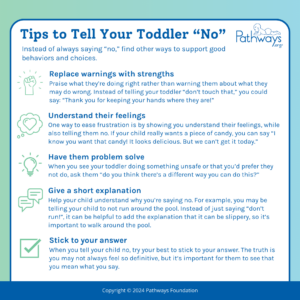Alternatives to Saying “No” to Your Toddler
- Telling your child “no” doesn’t always mean saying that word!
- Use alternative phrases to “no” to guide toddlers, encouraging positive behavior and helping to develop critical thinking skills.
- Promote positive behavior by praising what toddlers do right and involving them in problem-solving activities, teaching them safe and appropriate actions.
As your little one becomes more conversational, one of the hardest things can be figuring out how to tell your little one “no”. When you make a rule or take something away from your child, they may get upset, which isn’t fun for anyone! But often to keep your child safe or healthy, you have to say no— or something like it.
Telling your child “no” doesn’t always mean saying that word
Instead of always saying “no,” find other ways to support good behaviors and choices. When children feel like they have a choice or are asked to problem solve themselves, this can help develop executive function and other critical thinking skills. It also is expected for kids to push boundaries at this age, and there can be some benefit to letting them learn where boundaries are! Here are some tips to tell your toddler no.

1. Replace warnings with strengths
Imagine this: you walk into a store with your toddler and there’s a few fragile items within their reach. What do you say? You might want to say “don’t touch anything!” Sometimes it’s more helpful to praise what they’re doing right rather than warning them about what they may do wrong. So instead of telling them “don’t touch that,” you could say: “Thank you for keeping your hands where they are! These items are very fragile.”
2. Understand their feelings
Telling a toddler no can lead to a temper tantrum, which is your little one’s way of expressing frustration. One way to ease the frustration they feel is by showing you understand their feelings, while also telling them no. If your child really wants a piece of candy but you don’t want them to have it, you can say “I know you really want that piece of candy! It looks delicious. We unfortunately can’t get it today, but maybe another day!”
3. Have them problem solve
Instead of telling your toddler to stop doing something, but their problem solving skills to work! When you see your toddler doing something unsafe or that you’d prefer they not do, ask them “do you think there’s a different way you can do this?” Work with them or have them independently problem solve, and then praise them when they find a different solution.
4. Give a short explanation
You don’t always have to explain why you’re saying no! But sometimes it’s helpful to give an explanation, so your child understands why you’re asking them to do a certain thing. For example, you may be telling your child to not run around the pool. Instead of just saying “don’t run!”, it can be helpful to add the explanation that it can be slippery which can make it easier to fall, so to stay safe it’s important to walk around the pool.
5. Stick to your answer
When you tell your child no, try your best to stick to your answer. The truth is you may not always feel so definitive, but it’s important for them to see that you mean what you say. When they’re older, you might do more negotiating. But at this age, stick to what you say.
Use “no!” when you have to!
Sometimes you only have a few moments to tell your child what to do. Maybe they’re running in the opposite direction, or about to stick their little hand into a big birthday cake. It’s completely ok to tell your child “no!” or “stop!” when you need your child to change their actions immediately!

